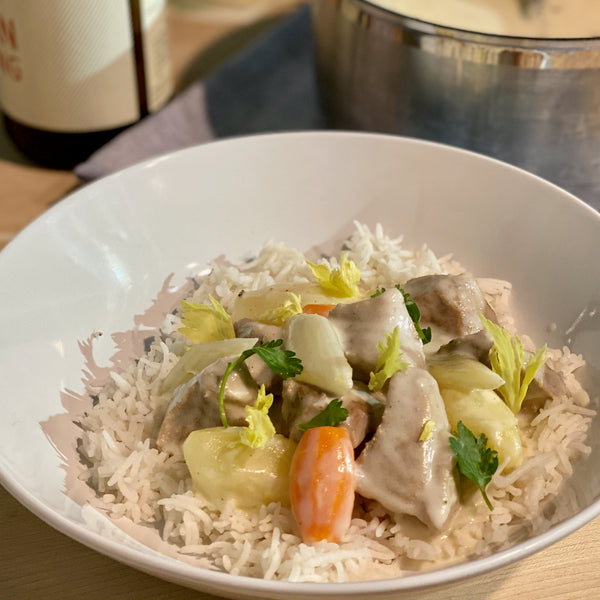
Blanquette de Veau
Blanquette de Veau is a warm and tender classic that holds space in both comfort food and fine dining. The version below has the classic steps without the extra details we would do in a restaurant (like cutting the vegetables into classic tournée shapes) to keep things casual. So put the pot on the stove, on a cozy Sunday afternoon and relax while the stew comes together. Bon appétit.
Category
Main Course
Servings/Yield
2-3
Author
Helen Park
Blanquette de Veau is a warm and tender classic that holds space in both comfort food and fine dining. The version below has the classic steps without the extra details we would do in a restaurant (like cutting the vegetables into classic tournée shapes) to keep things casual. So put the pot on on a cozy Sunday afternoon and relax while the stew comes together. Bon appétit.

Ingredients
2 pounds Veal shoulder stew meat, cut into 2” chunks
3 quarts water or neutral homemade chicken stock
1 small onion
-
2 cloves, studded into the onion
2 clove garlic, cracked
-
2 bay leaves
1 bouquet garni - tied together with string
-- 2 sprigs parsley
-- 2 sprigs thyme
-- ½ sprig rosemary
-
2 small yukon gold potato, peeled and cut into 1” chunks
2 small carrots, peeled and cut into 1” chunks
1stalk celery, cut into 1” chunks
4 oz button mushrooms, cleaned
-
¾ cup heavy cream
4 Tbsp butter, softened to room temperature
4 Tbsp all-purpose flour
-
¼ tsp Baharat
-
1 tsp ground Muntok Pepper
2 Tbsp lemon juice
-
Fine sea salt to taste
-
½ cup basmati rice
Directions
In a heavy saucepot or small Dutch oven, bring the veal, water, bay leaves, studded onion, garlic, and bouquet garni to boil.
Skim well and reduce the heat to simmer for 1 ½ hours or until the veal is tender – skimming as needed for a nice clear broth.
While the veal is cooking, rinse the rice until the water runs clear and drain well. Transfer the rice to a small heavy bottom pot with a lid and add 1 cup of fresh water. Leave the rice to soak for an hour.
When the veal is ready, remove the studded onion, garlic, and herbs.
Add the potato, carrots, celery, and mushrooms and bring the pot back to boil, skimming if needed.
Reduce the heat to simmer 10-15 minutes or until the vegetables are tender.
Cook the rice. Simmer the rice and water with a pinch of salt over medium heat until the water has almost completely cooked away. Cover the pot, turn the heat off, and leave to steam for 10 minutes or until the rice is tender. When the rice is ready, turn and fluff it with a fork or small silicon spatula and leave to rest, covered.
When the vegetables are ready, strain the meat and vegetables from the liquid and set aside.
Reduce the broth on high heat to 1 quart, then add the heavy cream.
Mix the butter and flour together to form a paste. This is called beurre manié.
Turn the heat to medium and whisk in the beurre manié, making sure there are no lumps.
Continue cooking the sauce 5 more minutes until smooth and thickened.
Add the meat and vegetables back to the sauce and finish with the Baharat, Muntok, lemon juice, and salt to taste.
Serve with the cooked rice.
Recipe Note
Recipe Notes
The recipe is made for two and can be multiplied easily for more.
Roux vs. beurre manié: Both are used to thicken soups and sauces.
Roux starts by cooking equal parts butter and flour, then adding liquid.
Beurre manié is not cooked before adding – it starts with the same equal parts of butter and flour, but they are mixed together to make a paste like dough that can be added to soups and sauces, little at a time while whisking to thicken. Beurre manié is a good way to add more rough-like thickness to liquids, sometimes when you haven’t started with enough roux in the beginning and want a thicker result in what you are making. Beurre manié can also be found in dishes that have a white presentation, like the blanquette, to keep things as white as possible (roux can sometimes get a little browned and result in a more golden result).
For those spices that typically aren’t eaten whole (Muntok pepper, allspice, star anise etc.) it is convenient to keep a little bit ground and ready – just do small batches to keep things fresh. This is the grinder Lior recommends and uses for small needs. It’s a little quieter, utilizes good technology to help with even grinding, and has a removable container for easy cleaning and storage.
Variations and Ideas
If fresh veal is not available locally, we sometimes can find it frozen from sites like Wild Fork.
The recipe also works well with boneless skinless chicken thighs.
Questions? Contact helen@laboiteny.com


